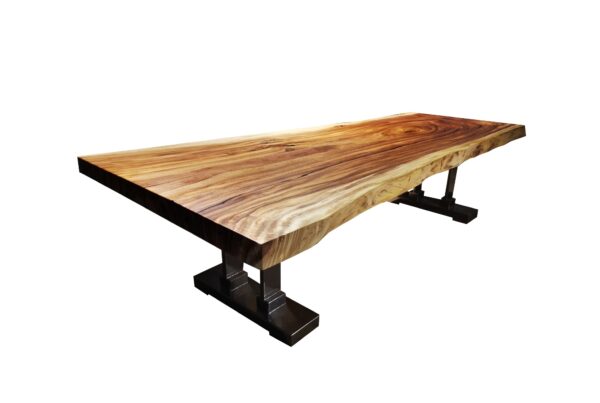
Furniture, Dining room furniture, Kitchen & dining tables, Solid wood tables
The timber manufacturing cycle begins with the natural resource, the tree, and ends with the finished product, such as chairs, furniture, tables, and floors, among other things.
The process is separated into two steps in general: from the natural resource to the semi-finished product, i.e. the planks. The planks are then transported to businesses and industries to be used in the production of completed goods such as dining room furniture, kitchen & dining tables and solid wood tables in general.
This short guide focuses on the first stage of the manufacturing process, which explains how the trees get all the way to be transformed into the wood planks that are commonly used to build our tables.
Cut and extraction of the tree is carried out
The first phase involves chopping trees in the forests with specialized chainsaws and tools. Trees from managed woods are obviously favored. The cut is made at the base and is done in the winter when there is less vegetative activity. Another process called limbing is also conducted on the spot. As the name says, all of the branches are removed until only the trunk remains.
The debarking and separation phase
The forest is left behind, and the logs are carried to the sawmill using excavator pliers. The following phase is known as debarking. It entails removing the bark either manually or with machines.
The logs are split into smaller pieces to make them easier to handle. The dimensions are usually predetermined. Blanking is another name for this phase. In some situations, these two processes might be completed in the forest in order to carry the already-cut pieces to the sawmill.

Washing and drying
We proceed with cleaning to remove all contaminants and other things from the wood that could attract parasites. Leaching is another term for this phase. After that, the wood is dried because too much water can destroy the valuable product.
When it comes to stacking, there are a few things to keep in mind. Stacking is one of the most crucial steps in the sawmill. Each log is analyzed and chosen based on its unique qualities.
The piles of logs, which are so lovely to behold in the mountains, are made up of pieces of similar sizes to make setting the cutting machines easier and to reduce wastage. Material handling devices such as excavator grapples are once again utilized to stack the logs that emit a distinct aroma.
The cutting phase: determining how to obtain the timber planks
The stacked wood must cure and rest before moving on to the crucial cutting process. The wood can be chopped into boards, beams, or battens to sell. There are numerous methods for cutting the tree, with the goal of obtaining the greatest number of boards with the least amount of trash.
On very precious wood, the tangential cut, also known as a Boule cut, is used to highlight the vein pattern. You do obtain very wide boards, but there is a lot of waste. When we use a radial cut, we get boards with a very dense grain that are also known as “rigatino”.
Other cutting techniques, such as quarter cutting, are also available. Different types of semi-finished items can be made by combining different types of cuts.
Other cutting techniques, such as quarter cutting, are also available. Different types of semi-finished items can be made by combining different types of cuts.
The LTJarbor offer
If you need a single slab live edge dining table top, we have plenty of custom options! Feel free to contact us and ask for more information. We also have an online portfolio with many examples of our work that can be adapted to your project.
article by:
A tech enthusiast with a passion for interior design,
architecture and modern technology.










